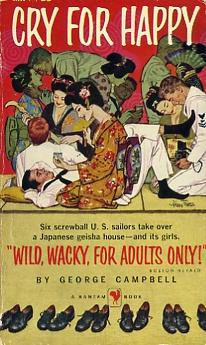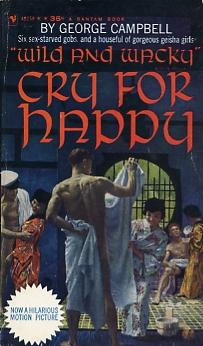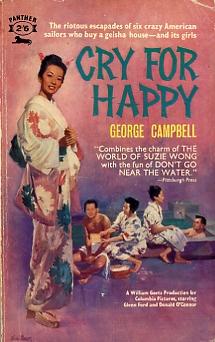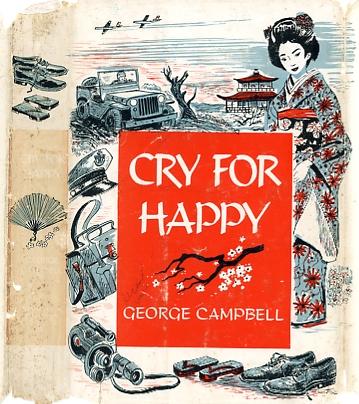Cry for Happy
A geisha house by any other name . . .
By William Wetherall
First posted 5 May 2010
Last updated 16 May 2010
Cry for HappyGeorge Campbell Hardcover editionNew York: Harcourt, Brace and Company, 1958 Paperback editionsNew York: Bantam Books, March 1959 (1st printing) New York: Bantam Books, March 1961 (4th printing) London: Panther, March 1961 (1st printing) CalligraphyAll the above editions include calligraphy by Michio Hanaoka. The title page of all editions show characters reading Šð‚µ‹ƒ‚« (ureshi naki), meaning "happy cry" as in Šð‚µ—Ü (ureshi namida) "happy tears". The chapter headings of all editions except the Panther paperback have characters for the chapter numbers. AuthorThe author appears to have been a captain in the Navy. |
1958 Harcourt, Brace and Company edition
Blurbs on front and back flaps of jacket
"How's you guys, all six of us, like to be partners in a geisha house?" -- and so begins a wild, delightful, charming, bittersweet, and satisfying a yarn as ever was told about the United States Navy. Wild? It all starts when Chief Andy Cyphers and his five sidekicks from the Pacific Fleet Combat Camera Unit are disciplined for wrecking a Servicemen's Club -- and wind up with just about the whole city of Tokyo off limits to them. Delightful? Wait till you discover, for example, how they make the Admiral's wife believe the geisha house is an orphanage, or how this Navy crew finagles all sorts of supplies from no less than a Brigadier General of the Army Quartermaster Corps. Charming? The charm comes by the half-dozen -- namely Chiyoko (Girl of a Thousand Ages), Hankichi (Lucky Flower), Harue (Branch of Spring), Yoshiko (Beautiful Girl Child), Koyuki (Little Snow), and Fujie (Wisteria Branch) -- backed up by the customs of centuries in the art of grace. Bittersweet? When was romance anything else -- and here it has to overcome the conflict of cultures and the demands of duty. And war has its losses as well as its triumphs, even for the victors. Satisfying? So satisfying in its plot and pace, in its adventure, in its humor and warmth, that a prominent Broadway producer is not adapting it for early stage production. But the full satisfaction in Cry for Happy comes from more than a fine yarn spun by an accomplished storyteller. It comes,in part, from the ring of authenticity that is evoked by the portrayal of person and place. It is no surprise that George Campbell knows the United States Navy well; he has devoted most of his adult life to the service. But only a keen observer could capture the essence of the Japanese as expressed in their conduct, their joys and sorrows, their homes, their customs, their supersitions, their values, their very landscape; and only a writer of real talent could blend all this into a fast-running, tight story. Perhaps the most satisfying factor in Cry for Happy is the rich measure of understanding that is apparent in it. Without pretension of any kind, and without losing pace or brightness, George Campbell achieves an extraordinary portrayal of ordinary people -- anywhere, everywhere. |
Blurbs on paperback editions
| Font cover blurbs | |
| 1959 Bantam |
Six screwball U. S. sailors take over a Japanese geisha house -- and its girls. "WILD, WACKY, FOR ADULTS ONLY!" (Boston Herald) |
| 1961 Bantam |
Six sex-starved gobs, and a houseful of goregous geisha girls "WILD AND WACKY" (Boston Herald) |
| 1961 Panther |
The riotous excapades of six crazy American sailors who buy a geisha house -- and its girls "Combines the charm of THE WORLD OF SUZIE WONG with the fun of DON'T GO NEAR THE WATER." (Pittsburgh Press) |
| Back cover blurbs | |
| 1959 Bantam |
SAILOR MEETS GEISHA
"Maybe you think a geisha girl is just a
"Combines the charm of THE WORLD OF
"A dilly of a story!" |
| 1961 Bantam |
BOOZE The hilarious, gut-busting novel and motion picture about the Navy chief and five swabbies who started their own Tokyo geisha house See Glenn Ford and Donald O'Connor in CRY FOR HAPPY, a Columbia Pictures release, co-starring Miiko Taka, Jamese Shigeta, and Miyoshi Umeki. Produced by William Goetz. A William Goetz Production. CinemaScope Eastman Color. |
| 1961 Panther |
"FOR ADULTS ONLY"
"How'd you guys, all six
A William Goetz Production in CinemaScope |
A funny thing happened on the way to Korea
The first-person narrator of Cry for Happy begins telling his tale like this (hardcover, pages 3-4)
|
"How'd you guys, all six of us, like to be partners in a geisha house?" When Chief Andy Cyphers said that, it was because the Navy had pushed us into a grim situation. We were practically outcasts. Maybe I'd better begin a little earlier. My name's Herman Pottle. When the Korean War started I was stuck in San Diego. I was only a photographer's mate third, but I knew my stuff, and San Diego didn't seem like a good place to waste it on. Not while there was some action going on somewhere else. So I tried to fanagle myself into a Combat Camera Unit. I may not be as good at finagling deals as Andy, but I'm a close second. |
Pottle never made it to Korea but is assigned to the photography unit run by Chief Cyphers. The men scheme of ways to make money and have fun, in the form of a geisha house disguised as an orphanage.
One of the men, Joe, falls in love with one of the girls, Harue, and they start jumping the bureaucratic hurdles to marry. In the meantime, the boys and girls fraternize in a legal gray zone in which they break a number of rules regarding fraternization and government property.
The admiral's wife, dubbed Mrs. Admiral in Pottle's narrative, decides to visit the orphanage aware that it is a geisha house. She, though, likes the boys and plays along with them.
"I'm not a babe"
Enroute to the orphanage, Pottle, who is driving, is stopped by an MP who has noticed something that duty requires him to investigate (hardcover, pages 193-195).
|
She [Mrs. Admiral] sat in the back seat yaking away with Joe, and Harue sat in front with me. I hit a steady pace, never going over the speed limit once. But a couple of miles outside of Yokohama a siren started blowing me down. I pulled over and stopped, and then a big lanky MP came striding over, hitching up his pants like all that hardware around his waist was about to half-mast his britches. Then he stuck his nose in my face. I said, "What's the beef?" He got his book out, and a pencil into his hand. "She a Japanese national?" he asked, looking at Harue. "What's she look like?" I didn't ask you that. What is she?" I motioned to Joe in the back seat. "His future wife." I didn't ask you that, neither." By this time the MP was getting mad. Believe me, I wasn't trying to get wise with that bird. I just didn't know where Harue stood. She was going to marry Joe, had been through the Brides' School, and so I asked the guy, "As a prospective American, hasn't she got any rights?" "None. She's still a Japanese national," the MP said, writing down the number of my car. He didn't ask why Harue was in the car, or nothing. It was enough for him that she was there. He said: "Let's see your ID card." I showed it to him and he wrote down my name and serial number. Then, although he hardly glanced at Joe and Mrs. Admiral in the back seat, it was a real dirty glance, and he said, "You sailors've got to learn you can't run around with a bunch of babes in government vehicles." Well, sir, until then Mrs. Admiral hadn't opened her mouth. As long as the MP was doing his duty she didn't interfere, but when he said "babes" she bounced off that back seat like she was shot, opened the door and stepped out. "Young man!" she said. "I was married to a naval officer when you were in diapers. And I'm not a babe. Neither is that little girl in the front seat. And since you haven't had the courtesy to ask who I am, I'll show you." Yanking a card out of her bag, she handed it to the MP. "Just attach this to your report slip. Tell your commanding officer that I will be there as a witness." The MP took one look at her card -- everybody knew who her husband was -- and wilted. "Lady, I'm sorry," he said. I was just doing my duty. I didn't mean you." "You said "babes," Mrs. Admiral reminded him. "That's enough for me. It's time you learned some manners. I never was so insulted in my life." The she founced into the car and said, "Pottle, drive on." "Yes, ma'am," I said, giving the MP a big yawn. As I drove away I looked into the rearview mirror. The MP was talking to Mrs. Admiral's driver, who had stopped when we did, and the last I saw of the MP he was throwing a wad of paper down on the road and stomping on it. |



